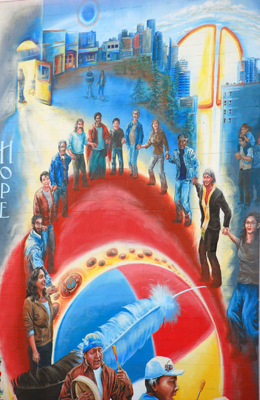Poverty
and Aboriginal Peoples

Poverty
has many proportions- measurable deficiency (food, shelter, sanitation, and
safe drinking water) social exclusion, lack of education, high unemployment and low
income. Each of these factors diminishes opportunities, limits choices,
undermines hope and threatens health. Poverty
is a burden to certain groups in society such as women, children, ethnic and
minority and the disabled (National Collaborating Centre For Aboriginal Health,
2009-2010, p. 1). Poverty is measured according to the “Low-Income-Cut-off” or
the income which a family is likely to spend 20% more of its income on basic
necessities than the average family. Poverty can be defined and measured in
both absolute and relative terms for Aboriginal people who experience poor and
unequal living conditions on a national or global scale (National Collaborating
Centre For Aboriginal Health, 2009-2010, p. 2). Aboriginal’s health mirrors
that of the world’s poorest, but is made worse by their social and cultural
marginalization.
According
to the Royal Commission of Aboriginal Peoples it supported that “Aboriginal
people are more dependent on many forms of Social Assistance as a primary
source of revenue than the rest of the Canadian inhabitants (RCAP 1996, 168)”. In
the year 2000 average income for Aboriginals was $13, 593 compared to average
income on non-Aboriginals population of $22, 431. Metis population had the
highest average income of Aboriginal groups ($16,347), Indians off reserve
($13, 838 and the Inuit ($13, 700). On reserve Indians had the lowest average
incomes (Statistics Canada 2004). In Canada aboriginals have one of the highest
rates of poverty than any other collective groups (Hick, 2007, p. 168).
·
69%
percent of Aboriginal people live off reserve
·
50% of all Aboriginal people now live in
urban areas
·
33% of Aboriginal children (0-14)
compared to 19% of non-Aboriginal children
·
Almost half (46%) of Aboriginal children
live with a lone parent
·
Forty percent of off-reserve Aboriginal
live in poverty
·
One in every four off-reserve Aboriginal
children live in poor housing conditions, compared to 13% of all children in
Canada
·
Urban Aboriginal peoples are a high risk
group for food insecurity
Funding
cuts for Aboriginal language programs, the Friendship Centres, programing
dedicated to urban Aboriginal children aged 6-12 were cut by the federal and
provincial governments (Hick, 2007, p. 168). More importantly since 1990 we
jeopardized longsighted high poverty in Aboriginal neighborhoods throughout
Canada’s major cities without investment and partnerships from federal and
provincial governments (Hick, 2007, p. 168). In 2001 Aboriginals had an
unemployment rate that is over twice as high as the general rate and only
earned only two thirds of an average workers wage even though the higher
education attainment and participation in the labour market had been achieved.
Rates
of poverty for Aboriginal women are more than double that of non-Aboriginal women
(National Collaborating Centre For Aboriginal Health, 2009-2010, p. 2). As a
result of living under conditions in poverty:
·
More than 100 first Nations communities
are currently under boil water advisories and have little or no access to clean
water for drinking and sanitation.
·
First Nations suffer from third world
diseases such as tuberculosis at eight to ten times higher the rate of
Canadians in general.
·
Aboriginal people are four times more
likely to be experiencing hunger as a direct result of poverty.
Looking at the issue of
poverty from a neo-conservative approach it acknowledges a federal
responsibility in reducing “inequalities” between Aboriginal and non-Aboriginal
Canadians but their main focus is education, the labor market integration or
land claim negotiations, rather than on low income and social conditions.
Individuals should be responsible for their own lives and policies that
encourage dependency on the state should be avoided. State regulation of
capitalism should be kept to a minimum and should not be used to promote anything but economic goals. Analyzing this from socialism approach, social and economic
equality is maximized which would be better suited to help eliminate poverty in
Canada, private ownership of property is replaced by collective ownership and
management. This would help take the focus off of the land claim negotiations
and focus on the problem at hand which is relative or absolute poverty.
Thanks Allison
References
http://www.edmonton.ca/environmental/capital_city_cleanup/hope-hunter-mural.aspx
Hick, Steven. (2007).
Social Welfare in Canada: Understanding
Income Security, Second Edition.



